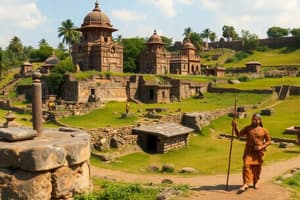Podcast
Questions and Answers
What does the word 'Veda' mean?
What does the word 'Veda' mean?
- To write
- To read
- To know (correct)
- To speak
Which of the following is NOT one of the four collections of the Mantras in Vedic texts?
Which of the following is NOT one of the four collections of the Mantras in Vedic texts?
- Atharvaveda
- Samaveda
- Bhagavad Gita (correct)
- Rigveda
What are the Brahmanas primarily about?
What are the Brahmanas primarily about?
- Sacrificial rituals and explanations of mantras (correct)
- Philosophical discussions
- Poetic hymns and chants
- Historical accounts of the Aryans
What are the Aranyakas and Upanishads considered in relation to the Brahmanas?
What are the Aranyakas and Upanishads considered in relation to the Brahmanas?
Which of these statements about the Vedas is true?
Which of these statements about the Vedas is true?
During which period did the use of iron implements become significant?
During which period did the use of iron implements become significant?
Which category of texts forms the core of the Vedic literature?
Which category of texts forms the core of the Vedic literature?
From where did the Aryans migrate?
From where did the Aryans migrate?
What is the significance of the term 'Vedanta'?
What is the significance of the term 'Vedanta'?
Which of the following describes a key change in Vedic people from 1000 BC to 600 BC?
Which of the following describes a key change in Vedic people from 1000 BC to 600 BC?
Flashcards are hidden until you start studying
Study Notes
The Vedic Age Overview
- Transition from the Harappan Civilization marked by urban decline around 1900 BC and emergence of rural settlements.
- Arrival of new groups called Aryans or Indo-Aryans coincided with Harappan decline, offering archeological evidence of migration.
- Vedic Age spans from 1500 BC to 600 BC, characterized by development of distinct cultural and societal features.
Objectives of Study
- Understand Vedic texts and their content.
- Identify Aryan migration regions and their early settlements.
- Differentiate between Early Vedic (1500 BC-1000 BC) and Later Vedic (1000 BC-600 BC) societies.
- Recognize the significance of iron implements in Later Vedic society.
- Examine changes in economic, social, religious, and political structures from 1000 BC to 600 BC.
Vedic Texts
- The term "Veda" derives from the root "vid," meaning "to know," indicating sacred knowledge contained within.
- Vedic literature consists of two main categories: Mantras and Brahmanas.
- Mantras: Core texts of Vedic literature, divided into four collections:
- Rigveda
- Samaveda
- Yajurveda
- Atharvaveda
- Brahmanas: Prose texts that explain mantras and sacrificial rituals, not to be confused with the Brahminical class.
- Mantras: Core texts of Vedic literature, divided into four collections:
- Together, the Vedas and Brahmanas are referred to as "shruti," meaning "that which was heard," indicating their divine origin as perceived by sages.
Additional Texts
- Aranyakas: Known as "forest writings," serve primarily as appendices to the Brahmanas.
- Upanishads: Philosophical discussions termed "Vedanta," meaning "end of the Veda," representing the culmination of Vedic thought.
Studying That Suits You
Use AI to generate personalized quizzes and flashcards to suit your learning preferences.




